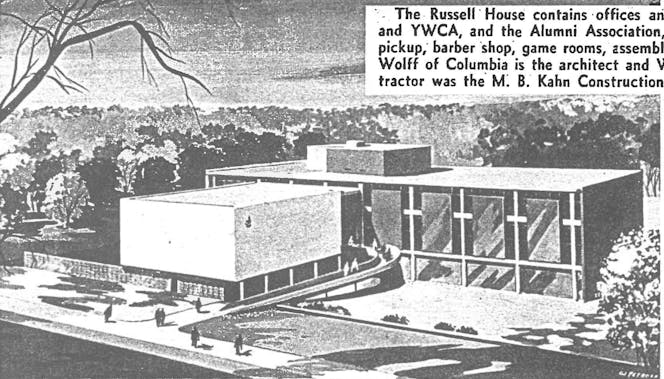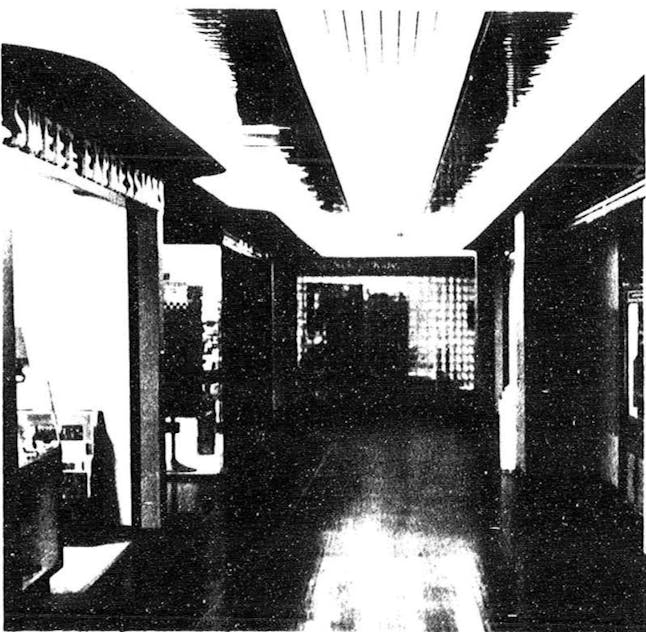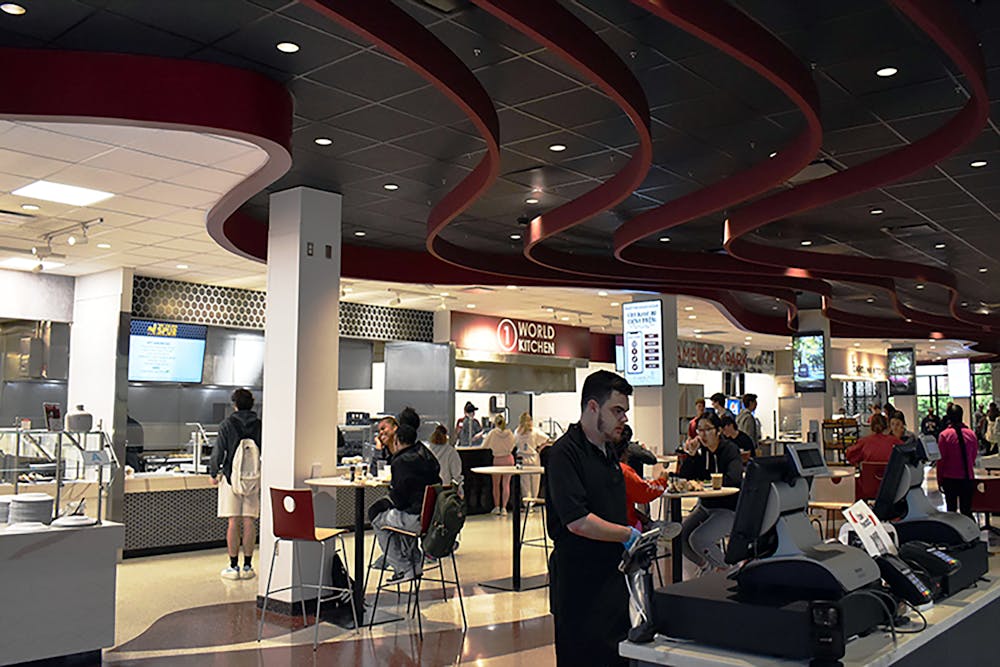Walking into the first floor of Russell House, the average Gamecock immediately notices crowds of students gathered around tables. Some are laughing with friends and sharing stories, while others are silently crying over their chemistry homework. They all share one thing in common: Food is what brings them to this place.
Russell House has served as an epicenter of campus since it was built in 1954. At the time, it was built to accommodate more than 4,000 students. Now, after many expansions and renovations, Russell House opened its doors to more than 34,000 students for the fall 2023 semester. Since its opening, Russell House has gone through multiple renovations to fit the student body. But this isn't the only example of how dining on campus has evolved.
Compiled from The Daily Gamecock’s archives, alumni and a variety of sources, here is a timeline of campus dining.

A drawing USC's student union, Russell House, during the 1950s. Russell House was built in 1954 to help accommodate the growing population at USC.
1954: Russell House opens for USC students, including a cafeteria with an air-conditioned dining room. The cafeteria can seat 684 at a time and serve 1,800 per meal.
1958: Russell House's dining area expands to a newly covered patio, adding 450 seats for students.
For some alumni, such as 83-year-old Nancy Bivins, Russell House cafeteria served as a convenient place to grab breakfast or lunch before class.
However, Bivins, who attended USC from 1957 to 1961, said she didn’t care to eat dinner on campus, as she preferred to go out with her friends.
“(Dinner) was boring,” Bivins said. “A lot of times, when you go into breakfast, you might be by yourself or with one girl coming from the dorm. And then at suppertime, it was more of a social thing to get out and go (to off-campus restaurants).”
1969: The University Union nightclub, The Golden Spur, located in Russell House, holds up to 200 people dine and dance. ARA-Slater Services, USC's food contractor service, begins to limit menu items and hours in cafeterias on campus after the company goes “$6,000 dollars in the red” in the fall semester. This is the second year ARA-Slater loses money at South Carolina.

A black and white photo of Russell House's basement in 1985. During the 1980s, Carolina Mall existed in Russell House's basement, carrying shops and dining locations for students.
1982: SAGA Food Services Inc. takes over in place of ARA Services, which had been USC’s dining service for 30 years. SAGA incorporates a new meal plan card where students can hand to cashiers when checking out.
1985: The Carolina Mall opens in Russell House's basement, where SAGA also places a sub shop.
1992: USC signs a five-year contract with Marriott Food Services, making it USC’s new food retail service.
1995: USC discusses plans to open a new dining facility in Russell House for specifically Preston College residents. Marriott adds a Baskin-Robbins ice cream stand on campus.
1997: USC re-signs a five-year contract with Marriott Food Services. As a part of the contract, Marriott puts a Chick-fil-A on campus alongside other new dining locations. The company also offers students the option of a block meal plan, where students can have a set number of meals per semester.
1998: Taco Bell opens on the second floor of Russell House.
For alumnus Kyle Banashek, 44, fast food options like Chick-fil-A and Taco Bell didn’t really compare to the cooking he ate in Russell House’s cafeteria.
Banashek, who attended USC from 1997 to 2001, said personable cooks such as “Peaches” made him favor Russell House's homestyle cooking for breakfast, lunch and dinner. By Banashek's senior year, Peaches had his breakfast order memorized and could serve it to him before he even asked.
“She was just a staple,” Banashek said. "She was always there, always smiling. Everyone knew who she was.”
2001: USC's Dining Services rebrands as “Carolina Dining” after food retail service Sodexo-Marriott creates a spin-off company, Sodexo Alliance, to oversee dining at USC.
2002: USC enters into a 15-year contract with Sodexo with a plan to renovate dining at the Grand Market Place, a food court on the first floor of Russell House, Bates House and Patterson Hall cafeterias and Gibbes Court.
A new off-campus access meal plan is offered to students so they can eat at independently-owned restaurants near campus. Eighteen restaurants are included in the plan, such as Beezer’s, Carolina Bagel and Domino’s.
2003: Cooper’s Corner, a coffee shop and cafe, opens on the main floor of Thomas Cooper Library. Renovations on the first and second floor of Russell House are completed, bringing four new retail dining options to students.
2006: The Colloquium opens on the east side of campus, serving sandwiches, salads, soups and other options.

A photo of a security guard in Russell House in 2009. In order to prevent students from stealing food, USC hired security guards to watch over people that were picking up food.
2009: USC hires security guards to prevent students from stealing food in Russell House. USC also tries to make dining on campus more eco-friendly by offering students a 10% discount if they eat on reusable plates.
2010: Einstein Bros. Bagels opens a new location on the east side of campus in the Welsh Humanities Office Building.
2011: Carolina Dining introduces “Flex” meals, a plan where upperclassmen receive a certain amount of “Flex” dollars per semester instead of a fixed amount of meal swipes per week.
2013: Carolina Dining replaces Burger King with Fresh Burger, a burger station run by USC’s food service provider Sodexo. Russell House also receives Wholly Habaneros, a cantina-style retail spot. Chick-fil-A begins serving breakfast, and Market 101, a convenience store, is added to McBryde.
2015: Carolina Dining makes adjustments to meal plans by getting rid of “Bonus Bucks” — meal plan dollars that were distributed to students based on their class. The amount of meal plan dollars is now determined by which tier a student wishes to purchase. “Flex” meals are also rebranded as a “declining balance” meal plan.
2017: Aramark, known on campus as Carolina Food Company, replaces Sodexo as USC’s food contractor service. The new contract is the second 15-year deal between USC and a food service.
2018: Campus gets its first fully-licensed Starbucks locations — one in Thomas Cooper Library and the other in the Welsh Humanities Classroom Building. Russell House undergoes summer renovations and receives a complete makeover on its first and second floors. Taco Bell and Pizza Hut are removed to make way for the relocated Chick-fil-A on the first floor. Carolina Food Co. adds new retail locations, such as Panera and Twisted Taco.
2019: Carolina Food Co. begins using Grubhub mobile ordering across USC’s campus, allowing students to order ahead on their phones.
2020: Campus shuts down during the spring semester as the COVID-19 pandemic begins, preventing students from being able to use their meal plans. USC refunds all students’ meal plans for the rest of the semester. In the fall, USC welcomes students back to campus, and Carolina Food Co. provides meals for students who are in quarantine.
2021: Carolina Food Co. launches its Residential All-Access Meal Plan, giving students unlimited visits to any of the five dining halls, two meal swipes per day that can be used at any of the retail locations and a starting amount of $200 meal plan dollars.
Carolina Food Co. also begins partnering with local food truck vendors to sell food to students during lunch hours on Greene Street throughout the week.

FILE — A photo of a person working on Russell House construction on June 7, 2022. Russell House underwent changes in its dining areas, including the addition of new dining hall.
2022: Over the summer, Russell House undergoes its second major renovation in four years, and the entire second floor converts from retail locations to a new dining hall, Gamecock Park. Certain retail locations, like Twisted Taco and Food Lab, are relocated to the first floor alongside a new Panda Express. Horseshoe Deli is moved to the Welsh Humanities side of campus, where it replaces Einstein Bros. Bagels.
Residential All-Access meal plans change the number of meal swipes allotted per week, going from 14 to seven. Students on the plan, however, now receive a starting amount of $250 meal plan dollars.
2023: Russell House changes a few of its retail locations, with Qdoba replacing Twisted Taco and the addition of the Halal Shack. The opening of Campus Village introduces USC’s sixth and largest dining hall option, the Pavilion.
Carolina Food Co. has no plans to stop there, according to Faren Alston, the marketing director for Carolina Food Co. Another fully-licensed Starbucks and a Jimmy John's are still expected to open in Campus Village this fall. Towards the end of the semester, the food service will also start incorporating 30 Starship delivery robotos across campus.

